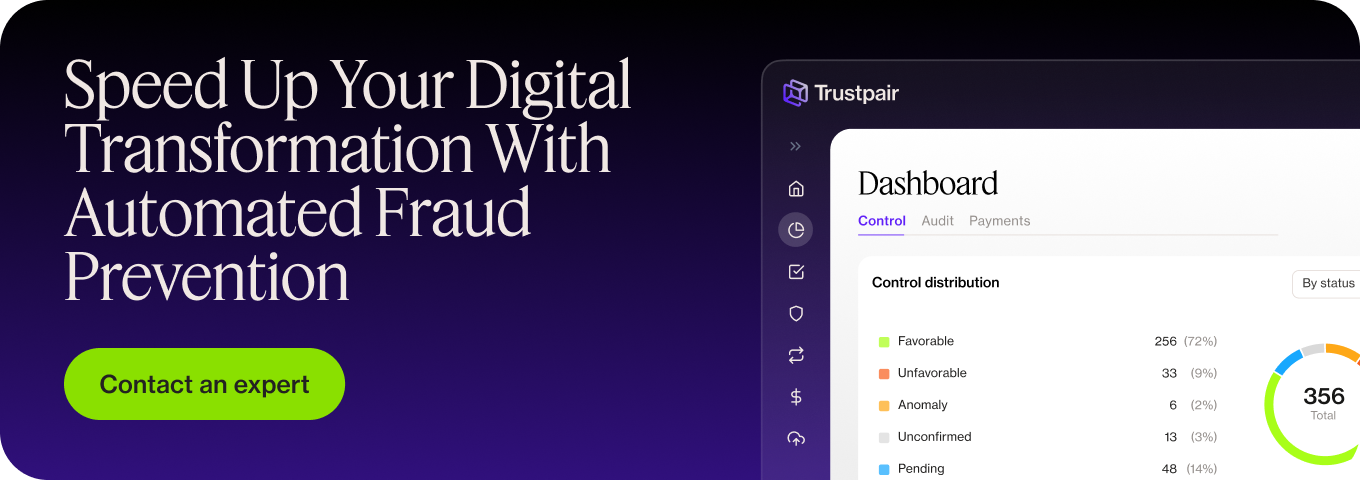Vendor compliance refers to the act of managing your third parties to meet your business and regulatory requirements, which is essential for resolving issues, and maintaining your own security and operational resilience.
In one case of vendor compliance gone wrong, Intel discovered that one of its suppliers had been embezzling money, in collusion with an ex-employee, to the tune of $842,000.
Learn about the best practices of a vendor compliance policy, and how to use tools like Trustpair to ensure that your data is both verified and meets compliance standards.
Key Takeaways:
- Vendor compliance is the management of third party business partners to support regulatory initiatives
- Effective vendor compliance is important because it helps to meet global standards and protects your entire supply chain from risks
- Poor vendor compliance can lead to fines, fraud, data breaches, and other security risks
- Regularly review the vendor compliance status as an essential task to prioritize
What is vendor compliance?
Vendor compliance is the process of ensuring that third parties can meet the minimum requirements of doing business for your organization. It assesses whether potential partners have the right procedures in place, and genuinely follow through with their plans when threats or issues arise.
Every enterprise relies on third party vendors, from office and energy suppliers to software subscriptions and even the caterers for your annual Christmas party. But if you’re subject to regulations, many of the same rules and restrictions extend to your suppliers.
Vendor compliance strategies can revolve around operations and product delivery, procurement and pricing, or communication channels and frequencies, for example.
Many vendor compliance requirements will be contractually obliged, meaning they are pre-agreed during the RFP process. A major part of this is simply collecting the vendor information when onboarding a new vendor, and completing regular audits. And in some industries, like highly-regulated finance, standard vendor requirements exist as the minimum or entry level requirements into the market.
Real life example: Morgan Stanley
When Morgan Stanley closed two data centres, they contracted a vendor to manage data services and hard drive destruction. But the company was inexperienced, and it ended up selling the hard drives, which contained millions of clients’ personally identifiable information, in an auction.
As the company that should have done better due diligence, Morgan Stanley paid a total of $161.5 million to the SEC, OCC and in lawsuits. They were charged with inadequately assessing the risks, failing to maintain an appropriate data inventory, and inadequacies in monitoring vendor performance, among others.
Why is vendor compliance important?
Establishing an effective vendor compliance program is vital for several reasons:
- It keeps the line of communication open between your team and your suppliers, which is especially helpful in better managed vendor relationships, especially resolving issues at speed and scale
- It holds vendors accountable, providing a standard operating procedure for recourse or raising disputes between your organization and your vendors, such as for late deliveries
- It strengthens your operational efficiency and resilience against disturbances or threats, even while relying on external resources
- When vendors comply, it helps with risk mitigation across the entire supply chain
- Having compliance documents to hand can be important cost savings measures in crisis prevention
- When vendors adhere and meet your consistent goals for compliance, it can support your governance, risk and compliance efforts
What are the key components of a vendor compliance program?
A systematic approach to vendor compliance management should include:
- Comprehensive risk assessments: gain complete visibility by collecting the right information, verifying the processes in place and evaluating the level of risk for potential vendors
- Integrated onboarding: intuitive data flows from your systems to the vendor compliance platform, enabling all of the information you have collected to be organised, stored and available
- Contract management: including managing contractual obligations and tools such as electronic signatures, and integrated extension tools
- Vendor ratings: red-amber-green (rag) automated alerts are popular ways to review vendors, helpful in assigning preferred suppliers and contract extension decisions
- Compliance monitoring: continuous monitoring is beneficial in order to effectively measure whether each third party is independently meeting your regulatory requirements
- Integrated offboarding: such as automated credentials changes as your contact changes roles, or removal of systems access controls entirely, in the case of offboarding
The risk and monitoring parts of vendor compliance programs should include a variation of components. These should cover a general code of conduct, implement communication and delivery expectations, security requirements and more:
| Component | Purpose | Examples |
| Risk level | After collecting the information for your risk assessment, risk scores a snapshot data | Severe: breach of regulatory rules leading to sanctions Major: persistent breakdown of key business or internal controls Moderate: reputation damage to critical clients Minor: immaterial financial cost to the business (>$1,000) |
| Data privacy | Meeting GDPR at minimum, but many organizations are sharing sensitive data with their third parties and need assurances that this data is protected | How does the supplier ensure the confidentiality and integrity of data? Does the supplier have regular penetration tests? Does the supplier outline their data encryption policy (at rest and in transit)? |
| Communication expectations | Open, available and strong communication is the key to building a good vendor relationship and better customer service | Who is the approved person to communicate with? How frequent should general check-ins be? How quickly should they inform you of an issue? |
| Incident response | A pre-agreed plan can help threat events go more smoothly, and get resolved quicker | What are the minimum viable systems to keep the relationship operational while systems are affected? How often are stress tests performed? |
| Performance | Measuring performance, and choosing vendors with better performance levels will enable your business to perform at a higher level | What is the service level agreement (SLA)? Has the vendor met their Key Performance Indicators (KPIs)? What are the product defect rates? |
What are the risks of poor vendor compliance?
Poor vendor compliance carries risks ranging from minor performance disturbances to full-blown reputational damage and regulatory penalties.
Regulatory risks
Since supplier compliance is often born out of a requirement for legal compliance, the vendor risks of regulatory non-compliance are significant:
- Fines: ranging from a few thousand in payment for individual perpetrators of vendor chargebacks, to company-wide fines worth millions of dollars, all stemming from poor oversight across vendor mistakes
- Operational disturbances: when regulatory violations occur, the accompanying investigations can disturb everyday workflows, leading to delays and exacerbating negative customer perceptions
- Reputational damage: the reputational damage that comes with regulatory violations can cause investors to pull out, a loss of contracts and harm ongoing revenue streams
Security risks
One of the biggest risks associated with poor vendor compliance is the increased vulnerability to attacks. When just a single vendor lacks strong security practices, it puts the whole supply chain at risk.
This can be caused by:
- Poor vendor controls: including failure to assign IT roles and responsibilities like gatekeepers, secondary approver, manager, and user
- Weaknesses in data security systems: such as software vulnerabilities, lack of data encryption, failure of email spam filtering
- Lack of vendor security training: employees that are unaware of typical phishing attacks and social engineering techniques are more at risk of falling victim
The security risks of poor vendor compliance typically lead to higher costs associated with surveillance and maintenance, too.
Performance risks
Alongside the operational disruptions, performance risks including inventory shortages, customer dissatisfaction and compromised quality are all related to poor vendor compliance. Without proper oversight, organizations that rely on third parties can risk sending out products that don’t meet their own quality obligations. This leads to friction with end-customers, because they are likely to feedback with complaints and could turn to one of your competitors.
What best practices to maintain vendor compliance over time
Best practices for maintaining vendor compliance include:
- Maintaining your vendor database
- Developing your supplier assessment
- Monitoring performance and actioning when required
Maintaining your vendor database
Say it with me: a clean vendor database is a healthy vendor database. Maintaining your vendor database means:
- Inputting enough data during onboarding (Know Your Supplier)
- Validating that data from the first day
- Monitoring the data for duplicates, change requests, or it becoming outdated
- Re-validating upon changes
- Removing vendors who no longer partner with you
It’s a lot of work, especially at an enterprise level when you’re working with thousands of vendors at a time. But that means that staying on top of it can become a full-time job in itself.
Automated vendor data cleaning solutions exist to verify, delete and enrich your supplier data to promote efficiency within vendor management and compliance. With an average of 30% of errors in all vendor databases, automated cleaning helps teams to stay resilient and efficient.
Developing your supplier assessment
Supplier assessment criteria are not typically prescribed by the regulators, so it’s up to each organization to decide what matters. For some, especially in highly-regulated industries, data confidentiality, encryption, transfer and practices are the most important for adherence to protocols like ISO31000.
For others, supplier performance matters more, including assessing SLAs and KPIs, quality control and inventory management.
Monitoring performance and actioning when required
Supplier performance is not only important in setting expectations, but also in the entire partnership journey. Regular or continual performance reviews enable you to gain transparency over vendor performance, and can check in when issues arise.
And in case a vendor is regularly failing to meet your expectations, part of vendor compliance also involves actioning, or offboarding. With a good system, you can make this process as painless as possible, keeping your data – and reputation – intact.
Vendor compliance is essential for businesses
Vendor compliance is essential because it ensures that suppliers meet agreed-upon standards for quality, safety, and ethical practices, reducing operational and legal risks. Ultimately, strong vendor compliance protects a company’s reputation and supports long-term financial stability. For help cleaning your vendor data, contact Trustpair.



